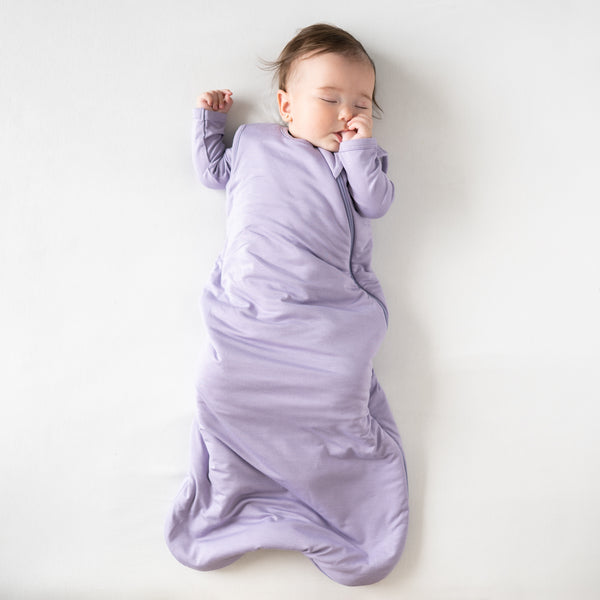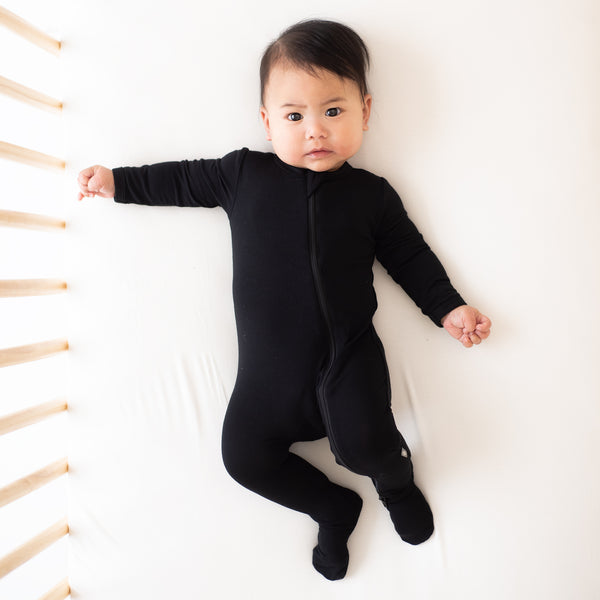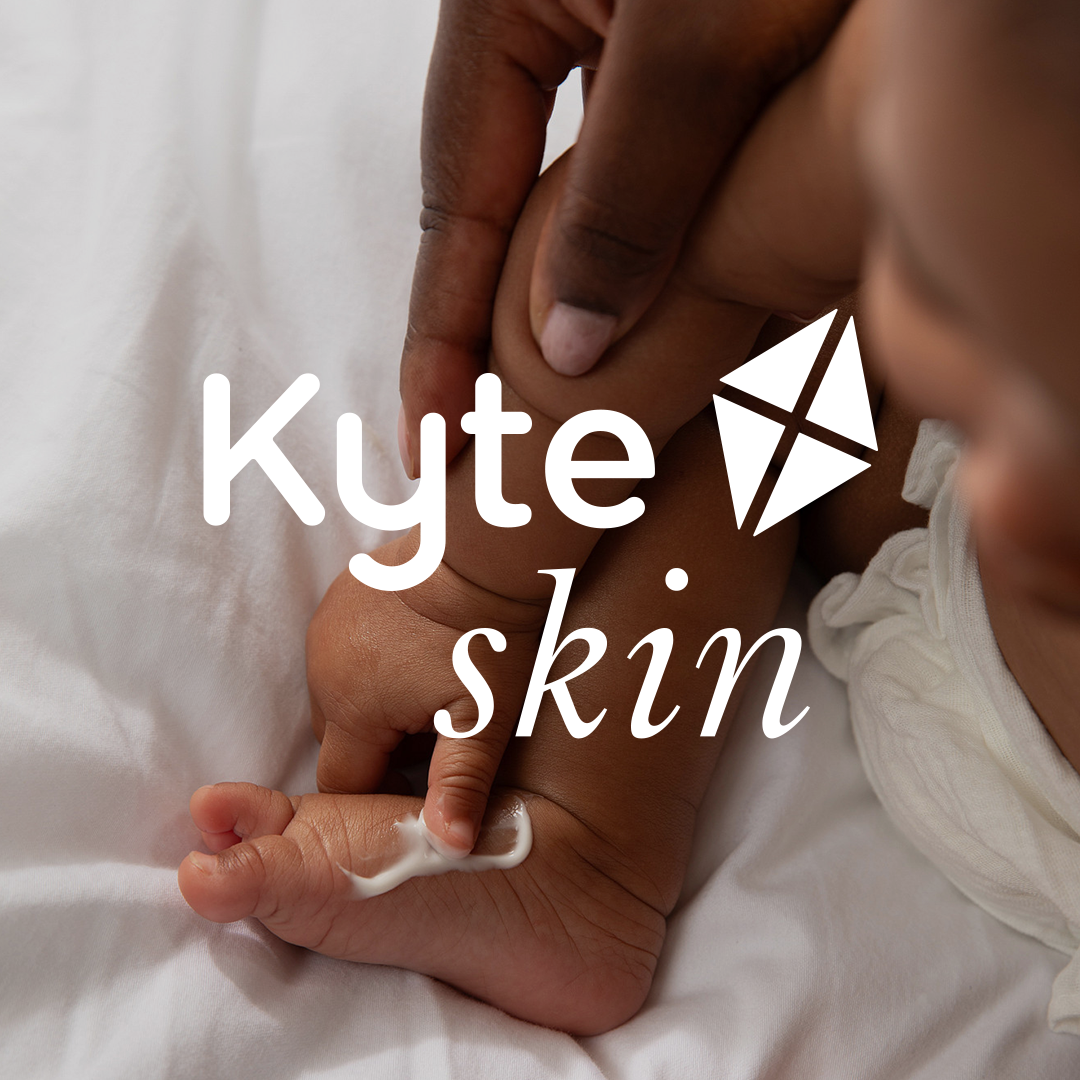For years (centuries, even), parents, grandparents, and doctors have chalked up night wakings to teething pain!
Drooling? Teething!
Fever? Teething!
Having trouble sleeping? Teething!
Chewing on their hands? Teething!
Sound familiar? Does it make you wonder how to soothe a teething baby at night?
I will be honest, teething sucks for us as parents! We know they are going to get teeth, but it is a total guess as to when. We never know what symptom is going to precede them.
Plus babies are a rollercoaster of ever-evolving behaviors. We often rely on teething as a helpful crutch to explain away “negative” behaviors that we desperately want the answer for.
Of course teething can cause discomfort, as there is typically swelling involved as the tooth rises to the surface. But is it enough to derail sleep for months? Research says otherwise!
We will cover all of that, plus:
-
When do babies start teething
-
Signs of teething
-
Teething fever
-
Teething remedies for 4 month old
-
Home remedies for teething babies
-
Safe teething remedies for babies
-
Baby teething crying at night/Can teething keep baby up at night?
-
What to do when baby is teething and won’t stop crying
-
Teething baby won’t sleep unless held
-
Baby teething pain worse at night (teething pains worse at night)
-
What helps a teething baby sleep?
-
How long do teething pains last?
-
How to take care of a baby's new teeth?
-
What if baby bites while nursing?
When do babies start teething?
Unfortunately, there is a wide range of “normal” for babies to get their first tooth! Some babies will get a tooth as early as 3 or 4 months, and others may not have a tooth until after their first birthday.
Around 3 months of age is when babies start to explore the world more with their hands/mouth and their salivary glands start to develop.
That means they are often chewing on their hands and drooling, so people tend to think their baby is starting to cut a tooth. When in reality, it is just a normal part of their development!
The first tooth or set of teeth to come in are the bottom two front teeth, typically. Most children will have all of their baby teeth by 3 years of age.
What are the signs of teething?

Not everything is a sign that a tooth is coming, but you may notice your child will exhibit a few symptoms each time they get a new tooth. Or you could be really lucky and they won’t have any signs!
They may just wake up with a new tooth- praise!
Some common symptoms/signs of teething to look for:
-
Look at their gums; if they are red and swollen, then a tooth is coming! This is actually the only reliable symptom across the board for the majority of kids.
-
Increased biting or sucking; they may want to chew on more toys than normal, or you may get bit while nursing
-
Irritable and fussy; especially the day or two before the tooth erupts
-
Disrupted sleep; maybe a night or two with some extra wakings are your child’s tell!
-
Decreased appetite
-
Ear pulling; this will relieve some of the pressure from their gums
-
Rash around their mouth from extra drooling
-
Mild fever known as “teething fever”
Fun fact: According to Science Based Medicine, “It was believed for at least a couple thousand years that teething could result in serious illness and even death. Remember how frequently a tooth emerges? Once a month, on average, for a couple of years, in early childhood.
People attributed severe illness and death to teething out of pure coincidence and a lack of systematic and logical approach to documenting and evaluating natural phenomena.
So it became widely accepted that teething was a source of fever, diarrhea, vomiting, seizures, tetanus and meningitis, to name just a few, and even death. It was not uncommon for teething to be listed as the cause of death in children prior to the late 19th century.”
Remember that so-called teething symptoms frequently occurred in non teething infants, too—it’s just that they were more likely to happen when the infants were teething.
They also found that no specific symptom occurred in more than 35 percent of teething infants. In other words, non teething kids often seem like they’re teething, and teething kids don’t all have the same symptoms. What a nightmare for parents.
“Despite hundreds of thousands of data points,” explains study co-author Michael Macknin, a Cleveland Clinic pediatrician, “we could not determine when a child was teething before a tooth appeared.”
The one thing Macknin could say for sure based on his data was that “a baby who drools or is fussy for weeks before a tooth eruption is not having symptoms due to teething.”
Teething fever?

According to this study regarding teething symptoms in babies, “Daily symptom data were available for 19 422 child-days and 475 tooth eruptions. Symptoms were only significantly more frequent in the 4 days before a tooth emergence, the day of the emergence, and 3 days after it, so this 8-day window was defined as the teething period.
Increased biting, drooling, gum-rubbing, sucking, irritability, wakefulness, ear-rubbing, facial rash, decreased appetite for solid foods, and mild temperature elevation were all statistically associated with teething.
Congestion, sleep disturbance, stool looseness, increased stool number, decreased appetite for liquids, cough, rashes other than facial rashes, fever over 102 degrees F, and vomiting were not significantly associated with tooth emergence.”
Basically, kids may have a mild increase in temperature due to inflammation prior to cutting a tooth, but not a high fever- that is usually related to something else!
Teething remedies for 4 month old? Home remedies for teething babies?
The best way to soothe a teething baby is just with some TLC (tender loving care). Snuggles, nursing often if you are breastfeeding, and throw in some frozen teething rings for good measure.
This section will be heavily based in science regarding other remedies like homeopathics, amber necklaces, and numbing gels.
Regarding homeopathic remedies:
I referenced poison control for information regarding homeopathy and this is what I found, “In homeopathic preparations, the active ingredient is so diluted that the final product contains little if any of that active ingredient.
On the back of a homeopathic preparation, active ingredients are not listed in milligrams. Instead, they are listed as a number and letter, such as 24X, 60X, or 400X. These indicate ratios of active ingredients to other ingredients.
An example: in a liquid preparation with a 6X ingredient, there is 0.000001 milliliter of active ingredient for every one milliliter of diluent solution. The higher the number, followed by the X, the more dilute the ingredient. 24X is approximately the point where no molecules of active ingredient are present.
Standard medical literature finds little if any evidence that homeopathy works at all. Non-homeopathic health practitioners generally believe that if a product is so dilute that it contains no active ingredient, it can have no effect except as a placebo (sugar pill).”
You can read more about the effectiveness of homeopathic remedies on the poison control website.
Regarding amber bracelets/necklaces/anklets:
Claims surrounding these accessories center around things like energy, thyroid stimulation to control drooling, and release of succinic acid.
Unfortunately, none of those claims are founded in evidence based science. You can read more in this article from a physician regarding amber teething accessories.
The number one reason to avoid amber necklaces is for the choking/strangulation hazard. The AAP has information about the hazard of using these as well.
Regarding numbing gels:
Numbing gels often contain an ingredient called Benzocaine. These products have been used for years, but in May 2018, the FDA declared that over-the-counter (OTC) benzocaine products are a serious risk to children and infants and said that these products should be taken off the market.
These products can cause a condition called methemoglobinemia.
This is a potentially deadly condition that causes blood to carry less oxygen.
Signs of methemoglobinemia may show either minutes or 1-2 hours after the use of lidocaine products. Symptoms include:
-
Pale, gray, or blue-colored skin, lips and nail beds
-
Trouble breathing
-
Tiredness
-
Headache
-
Lightheadedness
-
Racing heartbeat
What are some safe teething remedies?

Some easy, at home remedies for teething include:
-
Massaging their gums with your finger (the pressure helps)
-
Cold spoon or chilled (not entirely frozen) teething ring can be soothing
-
Cold washcloth (wet one end and stick it in the freezer for a little bit)
-
Gnawing on a cold cucumber, carrot, or any other cool/hard food (but be mindful of choking hazards)
-
I am not a fan of mesh baby feeders because they are very difficult to clean, but there are silicone ones available now and they are handy for teething babies. You can put partially frozen fruit (bananas work well) or even breastmilk ice cubes in them to give baby something cold to safely munch on.
-
Pacifiers
-
Teething biscuits (be sure to wipe their gums off after eating)
-
Certain silicone toys (hello, Sophie the giraffe!)
Baby teething crying at night, Can teething keep baby up at night, Baby teething pain worse at night (teething pains worse at night)?
According to the study linked above regarding teething symptoms, more serious symptoms, such as sleep awakenings, decreased appetite for solid foods, facial rashes, and slightly elevated temperatures (but not above 102 degrees), were more likely to occur one or two days before or on the same days a tooth came through.
But this study found no really serious symptoms associated with teething—no diarrhea, vomiting, high fevers, or reductions in the overall duration of sleep.
Again, no significant reductions in overall duration of sleep. Is teething more painful at night? Sort of.
This could be because children feel the symptoms of pain and discomfort most acutely when they have fewer distractions, and are exhausted. It’s the same reason adults feel more chronic pain at night.
Another reason pain may seem worse at night has to do with the increased levels of two cytokines that were found in the study referenced above. IL-1beta and TNFalpha are cytokines that were found to correlate with fever and sleep disturbances in teething babies.
Research has found that these signaling molecules have a direct impact on sleep, interacting with hormones and neurotransmitters that signal sleep-regulating neurons in the brain.
This is when we want to make sure that we are still providing a good baby sleep schedule and have realistic expectations for baby sleeping through the night.
What to do when baby is teething and won’t stop crying?
The evidence suggests that teething should not be so painful that you cannot comfort your child. If your child is crying without any end in sight, then that could indicate something else is going on and you should consult with your physician!
Teething pain should not require medical treatment. If your child is experiencing extreme pain or has a high fever, teething is probably not the cause and you should contact a medical professional.
A medical professional may suggest a dosage of Tylenol or Ibuprofen (over 6 months of age).
Teething baby won’t sleep unless held
When a tooth is erupting, there may be increased pressure which can cause ear pain like when they have an ear infection. You will want to rule that out for sure.
What helps a teething baby sleep?
For babies who are generally well-rested with a good sleep routine, you may never notice they are cutting a tooth! When they are well-rested, they simply handle any discomfort easier than kids who have a harder time sleeping.
Again, you will want to avoid any homeopathic remedies, amber bracelets, or numbing gels even when you are desperate for sleep.
If you do not see a tooth erupting, those sleep-deprived nights may have a different cause: a change in sleep patterns or the inability to fall asleep independently. You can read this blog to see if your baby is in a baby sleep regression or research some baby sleep training methods!
The consistency of a regular routine gives kids a solid foundation on which to build their own coping mechanisms.
How long do teething pains last?
From all the research listed above, at most, symptoms are noticed 4 days before a tooth erupts and up to 3 days after the tooth erupts.
One study even noted that symptoms were more prominent the day the tooth erupted and the day after!
So in short, not that long. It should not be weeks or months of “teething pains” without a tooth showing up. We can stop blaming teething if there isn’t a tooth within 8 days, essentially!
How to take care of a baby's new teeth?
According to the Mayo Clinic, to take care of new teeth you should, “Run a soft, clean cloth over your baby's gums twice a day — after the morning feeding and before bed. The cleansing can keep food debris and bacteria from building up in your baby's mouth.
When your baby's first teeth appear, use a small, soft-bristled toothbrush to clean his or her teeth twice a day. Until your child learns to spit — at about age 3 — use a smear of fluoride free toothpaste no bigger than the size of a grain of rice. Then switch to a pea-sized dollop as your child approaches 2 to 3 years of age.
It's also time to think about regular dental checkups. The American Dental Association and the American Academy of Pediatric Dentistry recommend scheduling a child's first dental visit at or near his or her first birthday.
Remember, regular childhood dental care helps set the stage for a lifetime of healthy teeth and gums.”
What if a baby bites while nursing?

The La Leche League (LLL) suggests what they call a PACED approach which stands for:
-
Position: review how your baby is latching (if you’ve gotten lazy now that your child is a little older, it can be easy to settle into an improper latch, but the La Leche League says that it’s physically impossible to bite with a good latch)
-
Act fast: watch for any sign that your baby may bite you, usually after the initial letdown and hunger is mostly satisfied. If you can catch it, quickly break your baby’s suction and sit baby up.
-
Comfort: obviously baby does not bite you with the intention of hurting you, but they may be very upset when you pull them off from feeding. Try to give a quick cuddle with a firm “no biting”, offer something else to bite (a cold teething ring) and then offer the breast if the baby is still hungry.
-
Expression/Compression: keep the milk flowing! Baby may grow bored when the flow slows down.
-
Distract: talk to your baby, play with them, etc while nursing to keep them actively engaged.
What are the 10 helpful tips to soothing a teething baby at night?
-
Maintain a regular schedule (now is not the time to go off script, remember that overtired babies do not handle discomfort as well so we want to keep them as rested as we can-- yes you can absolutely hold and rock that baby to sleep if that works for you!)
-
A consistent and relaxing bedtime routine (try to do the same steps each night to help them feel secure, something like feeding and bath, lotion massage, pajamas, books, lullabies)
-
Take shifts with your partner if you can, comforting when needed (maybe one parent takes the pre-midnight shift, and the other takes the midnight to morning shift, for example to give baby that extra support when the tooth is coming through)
-
Be proactive and try to have good sleep habits in place before teething begins (it is much harder to establish good habits if you are always questioning when the tooth might appear!)
-
If you’re giving over the counter medication (tylenol or ibuprofen) then give it about 30 minutes before bed to give it time to work (but this should be verified with your physician for the appropriate dosage + timing)
-
Use white noise as a distractor in the room + a lovey if your child is old enough to have one in the crib with them
-
Teething toys/things to chew on/cold things throughout your bedtime routine
-
Stay calm-- babies will pick up on any stress (which is hard to control when we are tired) but use soothing words/phrases/songs when calming your little one in the night
-
Baby wearing is helpful if they’re having trouble with naps and falling asleep at bedtime (only wear them if you are awake, if that wasn’t obvious)
-
Breastfeeding or using a pacifier can help with calming
When to call the doctor?
Most cases of teething can be handled at home, but you will want to inform your doctor of any high fevers, vomiting, diarrhea, if they are not eating or drinking like normal, or you suspect something else is causing pain/discomfort like an ear infection.
So, mamas, do you feel like you can handle teething a little more with these tips and evidence based research about teething symptoms?
I know it can be so hard to soothe a teething baby at night and you want all the answers on how to do it! But the fact remains that teething is often blamed for a lot of things and until the tooth actually emerges, you may miss the mark often on it actually being related to a tooth.
Just remember to avoid unnecessary remedies, offer comfort as needed, check in with your pediatrician if you suspect it is something more serious than a teething fever, and try not to speculate on when do babies start teething too often, it could be tomorrow or next month!
AUTHOR:
Ashley Olson is a certified pediatric sleep consultant, owner of Heaven Sent Sleep, and passionate about helping new parents, experienced parents, desperate and sleep-deprived parents form healthy sleep habits for their children.
She has over 3 years of experience in working with families and has completed over 150 hours of coursework plus continuing education related to infant and toddler sleep. The focus of her work is on fostering a routine that grows your bond with your child while improving their sleep habits. She specializes in custom sleep plans and one on one support in changing sleep practices!






















